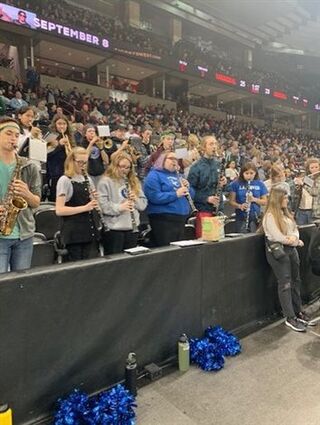Online music classes have different rhythm
December 9, 2020

AND THE BAND PLAYED ON, BACK IN THE OLD DAYS – Way back in March the La Conner school pep band could pile in a bus, go over the mountains to Spokane and pep up the high school girls basketball team and its many fans in the arena. In La Conner, practices were in a room, together, without face masks. Those were the days, my friends. Stay masked and away from each other to hasten their return –Photo courtesy of McKenzie Clark
The Gilkey Square tree lighting. Fall and spring concerts. Regional music educator festivals. Christmas wreath sales. Pep band. Maybe Disneyland.
COVID-19 wiped the 2020-21 school music calendar clean, leaving La Conner Director of Bands and Choirs McKenzie Clark and his students to make music on-line.
That is a challenge for an essentially face-to-face endeavor.
When meeting in person, music classes begin with call-and-response warm-up exercises. Clark sings or plays a line; students repeat it. Online, he sings or plays – and does not hear a thing.
“Students are muted because of the lag time between what they hear and their response,” says Clark. Twenty students means “20 different starting points to a song” – a recipe for cacophony. “I can only hope they are singing it back.”
In person, McKenzie can rehearse singers in sections, pulling them back together to polish a piece as an ensemble, often with this reporter at the piano. Tiny, separate squares on a laptop screen do not foster this natural rhythm of rehearsal and feedback, so he is teaching pieces that are sung or played in unison. The high school band has been working on “Cool Blues”, the high school and middle school choirs on “We Shall Overcome” and the “On, La Conner!” fight song.
After Clark teaches a passage, students practice it off-line before submitting a video or audio recording of their work. Through the La Conner school district’s on-line platform, Canvas, “I give them feedback as if I were in person. I tell them, ‘check your key signature’, ‘check your note’ or ‘you played all notes and rhythms right, now make it masterful.’”
Since there is no way to play or sing together, Clark often introduces musical literacy topics like note values and clefs. Sophomore choir member Hadley Shears finds that helpful. So does freshman Sammy Williams, who plays the trumpet.
“It helps me figure out what things mean more than on the surface, that helps me play better,” says Williams. “I am not just playing notes, I understand how the piece works and what it means and why.”
In-person classes teem with connection and belonging. “It’s hard to get that right now,” says Clark. “When we meet in person, our most active topic is how to we make music and ourselves sound better. Belonging is an awesome byproduct. Since we can’t sing together now, and we don’t have pep band, I focus on creating that feeling.”
Recently he had students do Show-and-Tell, “a fun silly thing to connect in a different way,” says Shears.
Williams felt that feeling of belonging when he represented La Conner Schools at the Honor Festival sponsored by the San Juan Music Educators Association. This annual event selects top regional music students to rehearse and perform under a guest conductor.
Instead of meeting at Western Washington University, students met on-line with the conductor and a tech assistant. Then, from home, they made two recordings of themselves playing their part – one audio, one video – that will be mixed into one group performance video.
“I love being in a band and this was just like normal band but a whole lot larger than La Conner,” he says. “Seeing all the different instruments and parts, I’m excited to see how it turns out.”
Next semester, middle school band begins. Many sixth graders were just learning their instruments when band was cut short last March. “It will be a challenge to teach sheer beginners on the internet but I’m looking forward to it, and if there are opportunities for in-person classes in the spring we will use them,” says Clark.
As they fine-tune their virtual teaching skills, music educators like Clark are pondering how and when young musicians can perform together safely.
For guidance, they look to best practices emerging from the Aerosol Research Study for the performing arts led by the University of Colorado, which is investigating the effects of COVID-19 aerosol transmission in performance settings.
Studying events like last spring’s Skagit Valley Chorale super-spreader rehearsal have revealed that performing outdoors is safer than indoors; low volume is safer than loud; small groups are safer than large; shorter is better than longer (aerosols quickly accumulate indoors); and social distance is safest. Singers should use specially designed singer’s masks; wind and brass players should use instrument covers.
Whether La Conner musicians can gather in person this spring or next fall, “that first day when we’re back together will be special,” says Clark.
Shears agrees. “Choir is a fun class no matter what format it is, but in person it’s fun to sing as a group because on Zoom we can’t really do that.”
Says Clark, “in the long run, I think kids will be grateful to have had these strange opportunities to invest in themselves as musicians.”








Reader Comments(0)